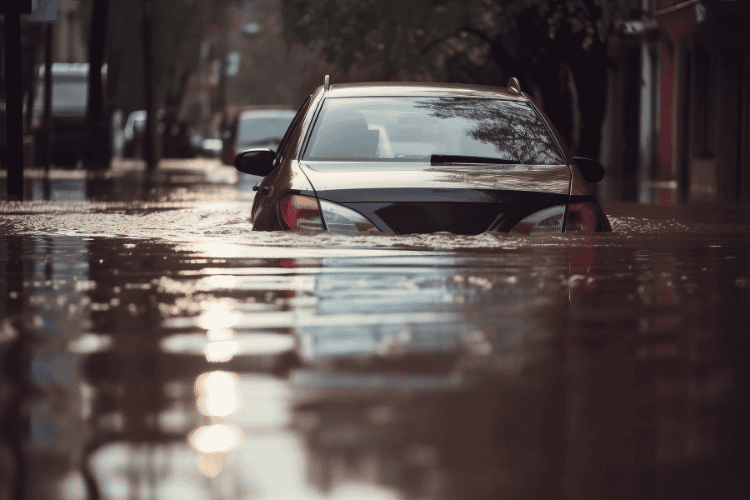
14 Aug How Do I Know If My Car Is Covered If It Floods?
Last hurricane season, my neighbor’s car was totaled by flood water, and she was shocked to discover she didn’t know if her car is covered if it floods under her insurance policy. After helping her navigate the claims process, I learned precisely what determines whether your vehicle is protected. Understanding your coverage before disaster strikes can save you thousands of dollars.
How do you know if your car is covered if it floods? Your car is only covered for flood damage if you have coverage as part of your auto insurance policy. Liability-only policies and collision coverage will not pay for flood damage. Check your policy declarations page or contact your insurance agent to confirm you have comprehensive coverage.
Many drivers mistakenly believe their “full coverage” automatically includes flood protection, but this isn’t always the case. There are important details about deductibles, coverage limits, and exclusions that could affect your claim.
Understanding Comprehensive Coverage and Flood Protection
Comprehensive coverage is the specific type of auto insurance that protects your vehicle against flood damage. Unlike liability or collision coverage, comprehensive coverage protects against natural disasters, including floods, hurricanes, and storm damage.
Comprehensive coverage applies to flood damage from any source – hurricanes, flash floods, burst water mains, or driving through flooded roads. It covers both mechanical damage and interior damage to your engine, electrical systems, and upholstery.
However, comprehensive coverage is optional in most states. Many drivers with “full coverage” only carry state-required minimums or add collision but skip comprehensively to save money. This leaves them vulnerable to flood damage. Comprehensive coverage typically costs $100-400 annually, making it affordable protection against devastating flood damage. To verify your coverage, look for “comprehensive” on your insurance declarations page or contact your agent directly.
What Your Policy Will and Won’t Cover
Comprehensive policies cover the vehicle itself, including engine damage, electrical repairs, interior cleaning, and mechanical components damaged by water. Your policy covers repair costs up to your vehicle’s actual cash value, minus your deductible.
Important limitations exist. Personal belongings inside the vehicle aren’t covered by auto insurance – claim these through homeowner’s or renter’s insurance. Aftermarket modifications not declared to your insurer may not be fully covered.
Some policies exclude certain water damage types. If you intentionally drive into flood water against warnings, your claim might be denied. Pre-existing maintenance issues won’t be covered as flood damage. Your deductible ranges from $100 to $1,000, which you pay out of pocket before coverage begins. Higher deductibles lower your premium, but increase upfront claim costs.
Steps to Take Immediately After Flood Damage
Never attempt to start a flooded vehicle. Starting a car with water in the engine can cause damage that insurance won’t cover if they determine you made it worse. Document everything first. Take photos of water level markers, the surrounding flood area, and all visible damage. Photograph the interior, engine bay, and exterior from multiple angles. This proves the extent of flooding and helps with coverage disputes.
Contact your insurance company immediately using their 24/7 claim hotlines. Starting the process quickly speeds up settlement. Be honest with adjusters but stick to facts. Have your vehicle towed rather than driving it. Most comprehensive policies include towing coverage. Keep all receipts for towing, rental cars, and emergency damage prevention – these are often reimbursable.
When Your Vehicle Becomes a Total Loss
Insurance companies declare total loss when repair costs exceed 75-80% of your vehicle’s pre-flood value. This happens more often with flood damage due to extensive, expensive water damage repairs.
Vehicles with water above the dashboard level are almost always total losses because water affects numerous expensive electronic systems. When declared a total loss, you receive your vehicle’s actual cash value minus your deductible.
You can negotiate settlement amounts if you disagree. Documentation like maintenance records, repair receipts, or comparable vehicle listings can support higher settlement requests.
Related Questions
Does homeowner’s insurance cover cars damaged in floods?
Answer: No, homeowner’s insurance excludes motor vehicles. Only comprehensive coverage on your auto insurance protects your vehicle from flood damage.
Can I buy flood coverage after a storm is announced?
Answer: No, most insurers won’t allow comprehensive coverage additions once a weather event is named or warned about in your area.
What if my financed car gets flooded?
Answer: Financed vehicles typically require comprehensive coverage, so you should be protected. However, if insurance payouts are less than what you owe, you’re responsible for the difference unless you have gap insurance.


Sorry, the comment form is closed at this time.